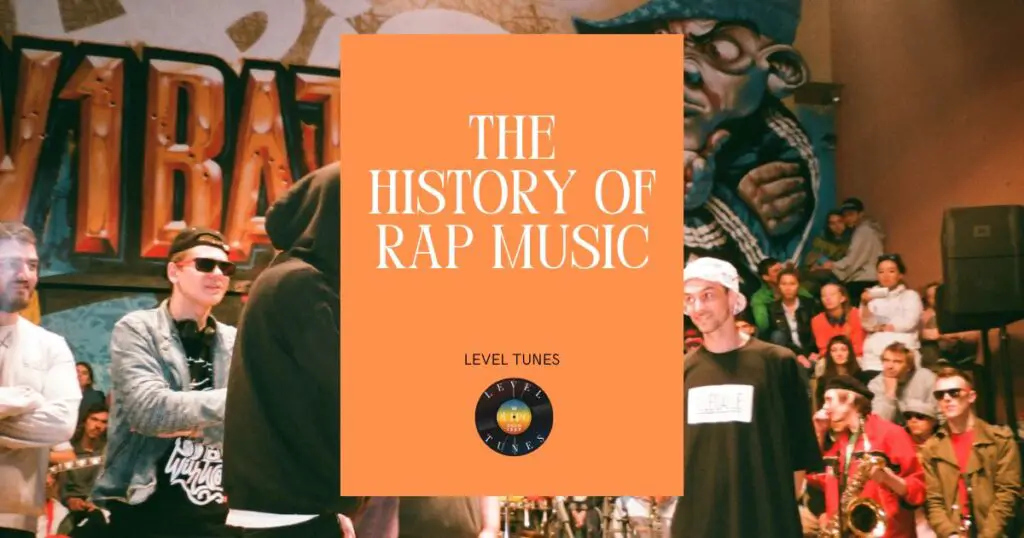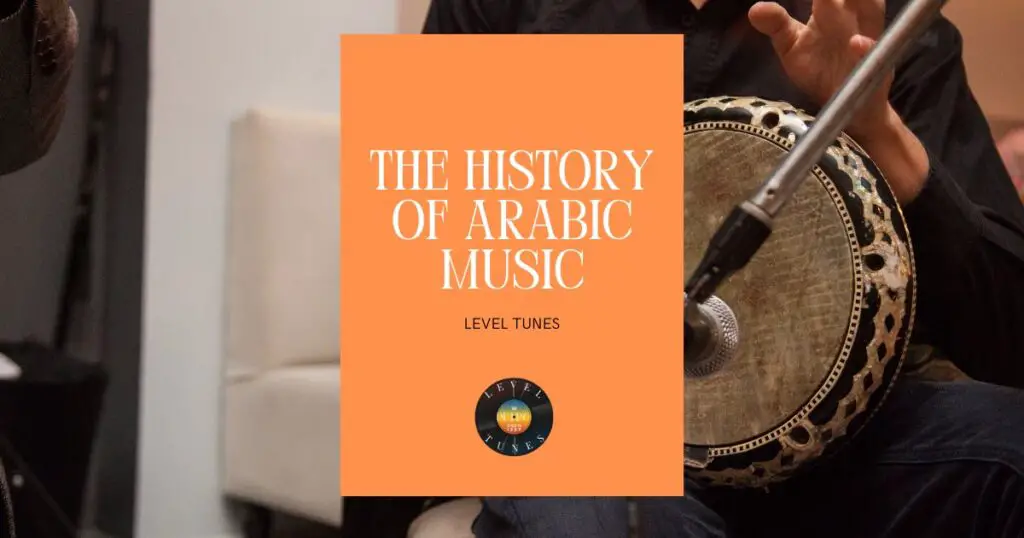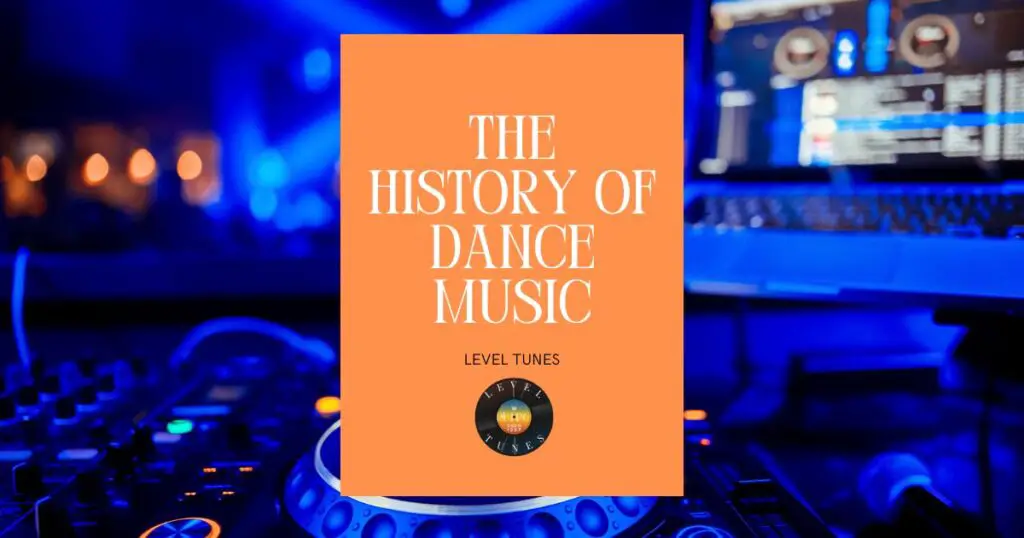Rap music, an artistic revolution that conquered the world in a few decades, has left an indelible mark on the global musical landscape. With its roots deeply embedded in African American communities and West African griot traditions, rap emerged as a powerful form of expression during the 1970s in New York City’s Bronx borough.
From its humble beginnings at street parties to influencing fashion and transcending cultural boundaries, rap music has continuously evolved and adapted to changing times.
In this blog post, we journey through the fascinating history of rap music; exploring its origins, impact on society and culture, controversies that fuelled debates over freedom of speech, and how it continues to inspire new generations of artists today.
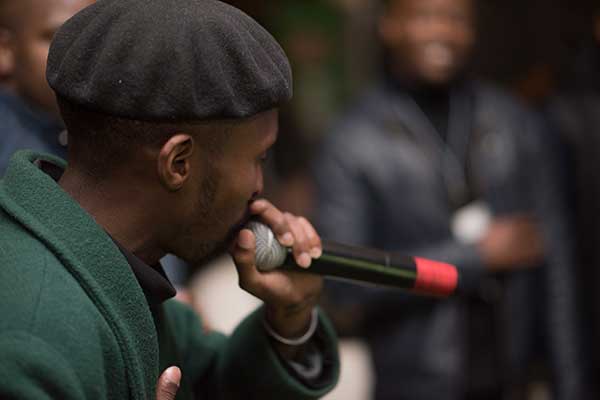
Key Takeaways
- The roots of rap music can be traced back to African – American griot traditions and Jamaican sound systems, which influenced its style, beats and lyrical substance.
- Block parties in the Bronx during the 1970s were pivotal in developing rap music as we know it today. MCs and DJs took centre stage showcasing their skills, with breakdancing being one of its primary features.
- Rap Music emerged as a societal and political voice for oppressed communities through artists like Grandmaster Flash and Public Enemy during the Golden Age of Rap Music (late 1980s to early 1990s). Today’s generation sees rappers like Kendrick Lamar and J.Cole continue this trend by bringing attention to socio-economic problems affecting minority groups.

Roots Of Rap Music: African And Jamaican Heritage
The roots of rap music can be traced back to the African Griot tradition and Jamaican sound systems, where artists recited rhythmic poetry over drumbeats and reggae beats.
The African Griot Tradition
The African Griot tradition holds a significant place in the roots of rap music, providing a strong connection between the modern genre and its rich cultural heritage.
Stemming from West Africa, this storytelling practice was carried over during the slave trade and has since become an inseparable aspect of African-American culture.
Fascinatingly, it can be argued that Africans have been rapping long before rap music came into existence as we know it today. The rhythmic storytelling style deeply ingrained in the Griot tradition has greatly influenced contemporary rappers’ techniques – showcasing their verbal dexterity and clever wordplay alongside captivating beats echoing age-old musical expressions.
Jamaican Sound Systems And Toasting
Jamaican sound systems and toasting have undeniably played a significant role in shaping the roots of rap music. As early as the 1950s, Jamaican sound systems emerged as an integral part of the island’s culture by providing venues for musicians to showcase their talents and fostering a strong party-based atmosphere.
As this vibrant movement continued to spread, so did popular Caribbean music genres such as dancehall, reggae, calypso, and dub. It is here where we see the birth of “toasting”, a technique that involves chanting or speaking rhythmically over a beat which became increasingly popular during the 1960s on these Jamaican shores.
With sound systems acting like fertile ground for experimentation and creativity, it was only natural that elements from their subculture would find its way into hip hop’s early beginnings in New York City during the 1970s.
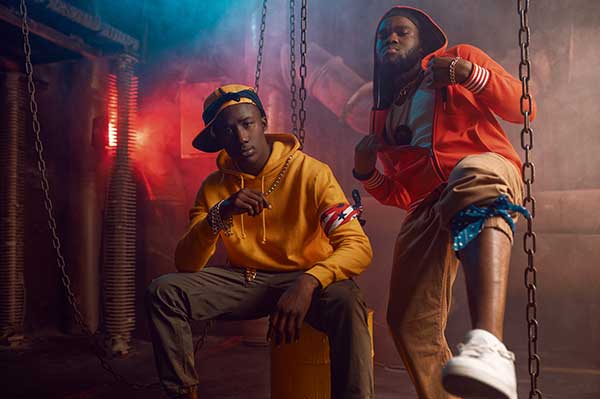
The Birth Of Hip Hop In New York City
The birth of hip hop in New York City during the 1970s was a transformative time for urban culture and music history. As I walked down those vibrant streets back then, immersed in the rich tapestry of African diaspora and reggae influence, I couldn’t help but be captivated by the ground-breaking artistry emerging from within those inner-city communities.
In those early days, iconic venues like Kool Herc’s parties at 1520 Sedgwick Avenue served as incubators for this burgeoning new musical genre. Characters such as Afrika Bambaataa, DJ Kool Herc and Grandmaster Flash took centre stage amidst swirling street art and breakdancing circles.
They pioneered this revolutionary blend of beats and rhymes – an intoxicating mix that encapsulated both social commentary and self-expression.
As someone who lived through this extraordinary era first-hand, there is no underestimating the impact New York City had on rap’s inception – shaping its roots through cultural heritage forged in adversity; providing stages where pioneering artists honed their craft; cultivating revolutionary new ideas forged through shared struggle; all culminating into what we know today as a genre that continues to evolve with each passing year.
Early Days Of Rap Music: MCs And DJs Take Center Stage
Block parties and breakdancing were the highlights of early rap music, with MCs and DJs taking center stage to showcase their skills.
Block Parties And Breakdancing
Block parties played a fundamental role in the emergence of hip hop culture and were the birthplace of rap music. In the early days of hip hop, block parties were where people from different backgrounds gathered to share their common love for music, dance, and art.
DJs would set up turntables on street corners. playing funk and soul records while MCs rapped and hyped up the crowd.
The origins of breaking can be traced back to South Bronx during the late 1970s when young African American youth began to incorporate various styles of dancing into their routines.
They found inspiration in martial arts films such as Bruce Lee’s Enter the Dragon (1973) which showcased acrobatic moves that involved jumping through kicks; this move later evolved into aerial flares seen today.
The Emergence Of Public Enemy
As rap music gained popularity in the early 80s, Public Enemy emerged as a fierce and radical force within the genre. Known for their confrontational style and politically charged lyrics, Public Enemy quickly established themselves as a major voice in the movement for social justice.
Led by MC Chuck D and hype man Flavor Flav, the group released landmark albums such as “It Takes a Nation of Millions to Hold Us Back” and “Fear of a Black Planet”.
Public Enemy’s sound was dense and layered, with samples drawn from diverse sources ranging from African rhythms to rock guitars. The group’s message was equally potent, addressing issues such as police brutality, institutional racism, and economic inequality.
Over the years, Chuck D has continued to use hip hop as a tool for political activism through his work with groups like Rapstation.com and his solo projects.
Run-DMC’s Mainstream Success
As the first hip hop group to find mainstream success outside of rap communities, Run-DMC played a pivotal role in bringing hip hop music to a wider audience.
Their third album “Raising Hell” released in 1986 is credited with kick-starting hip hop’s golden age. With hits like “Walk This Way,” which featured rock band Aerosmith, and their classic track “It’s Like That”, Run-DMC created a crossover appeal that attracted fans from all walks of life.
Their deliberate decision to create hip hop music that appealed to a broader audience set them apart from their peers and catapulted them into commercial success beyond what had been seen before in the genre.

The Golden Age Of Rap Music: Hip Hop Culture And Social Commentary
During the Golden Age of Rap Music, social commentary was a prevalent theme in hip hop culture, with artists like Grandmaster Flash and Public Enemy using their music to address political and social issues.
Political And Social Issues In Rap Music
As hip hop culture expanded into a global phenomenon, rap music became a platform for artists to express their views on political and social issues. During the Golden Age of Rap Music in the late 80s to early 90s, rappers brought attention to various topics such as police brutality, poverty, racism and socioeconomic inequality.
Public Enemy’s iconic “Fight The Power” spoke out against institutionalized racism and systemic oppression while Grandmaster Flash tackled drug addiction with his anti-cocaine anthem “White Lines”.
Today’s rap scene continues this trend, with artists like Kendrick Lamar and J.Cole addressing themes like drug abuse in minority communities and celebrating black excellence through their lyrics.
In short, hip hop has never shied away from being vocal about important social issues that affect our daily lives.
Hip hop is not solely entertainment but also serves as a powerful tool for social commentary on contemporary society. It has brought forth narratives that have often been ignored by mainstream media or underrepresented in popular discourse; creating an avenue for marginalized groups to have their voices heard.
The Legacy Of Grandmaster Flash
Grandmaster Flash, along with his group the Furious Five, is widely regarded as one of the most important figures in hip-hop music history. The group was instrumental in the development of hip-hop, and their groundbreaking use of turntables and records helped shape the sound of rap music.
Grandmaster Flash’s career has been described as a roller-coaster ride and is as improbable and distinctively New York as hip-hop itself. His hit song “The Message” is considered a landmark of socially conscious rap, addressing issues such as poverty and drug addiction that were affecting communities across America at the time.
The Artistic Evolution Of Rap Music
As rap music emerged, it quickly became a platform for social commentary. Grandmaster Flash, a DJ and early pioneer of the genre, used his records to convey messages about life in the Bronx.
Rap artists continued this tradition throughout the 1980s and 1990s as hip hop culture expanded beyond New York City’s borders.
In recent years, rap music has continued to evolve artistically with new subgenres emerging such as trap music which is notable for its heavy basslines and use of auto-tune effects.
This has led to some criticism from fans who believe that the genre is losing touch with its roots in street culture.
Controversy And Criticism: Gangsta Rap And Selling Out
Gangsta rap faced criticism and controversy for its graphic lyrics about violence, drug use, and misogyny, leading to debates over freedom of expression in the music industry.
The Debate Over Freedom Of Expression
Rap music has long been a subject of controversy, particularly when it comes to the issue of freedom of expression. Some argue that rap lyrics can incite violence or promote lawlessness, leading to calls for censorship and restrictions on the genre.
The debate over freedom of expression in rap music reached a peak in 1990 when Ice-T released his song “Cop Killer,” which was seen by some as promoting violence against police officers.
The controversy led to a censorship scare that threatened the industry’s creative freedom. Despite these challenges, many artists continued to push boundaries with their lyrics, addressing social issues such as racism and poverty through their music.
Criticisms Of Popularity And Commercialism
As rap music became more mainstream, it faced criticism for becoming too commercialized. With record labels and marketing driving the genre’s direction, some fans felt that it lost touch with its roots as a form of self-expression for marginalized communities.
Furthermore, the commercialization of gangsta rap has led to widespread criticism with many arguing that it promotes violent lifestyles and negative stereotypes about black people.
This subgenre has been particularly controversial due to its explicit lyrics about sex, drugs, crime and violence which have been seen as promoting anti-social behaviors among young listeners.
The Rise Of Alternative Hip Hop
Alternative hip hop emerged in the late 1980s and early 1990s as a distinct sub-genre of rap music. This new brand of hip hop placed emphasis on musical elements such as jazz, funk, and soul, while still maintaining a commitment to social commentary and political activism.
One example of alternative hip hop is the group A Tribe Called Quest. Their use of jazzy samples and socially conscious lyrics set them apart from other popular groups at the time like N.W.A.
Another influential alternative hip hop artist was Mos Def, whose fusion of poetry, jazz, and soul earned him critical acclaim.
The rise of alternative hip hop represented a turn away from mainstream commercialism in favour of greater artistic innovation and experimentation within the genre.
Women In Rap Music: Breaking Gender Barriers
Women have played a vital role in rap music since the beginning, from pioneers like MC Sha-Rock to modern-day icons like Nicki Minaj and Cardi B.
The Role Of Women In Early Rap Music
Women who were part of early rap music play an essential role in the industry’s development, but their contributions are often overlooked. Despite facing discrimination and marginalization, female rappers used their voices to address social justice issues like domestic violence and sexism in a male-dominated space.
Pioneers like Queen Latifah and MC Lyte paved the way for future female artists in hip-hop culture.
Sadly, there is still a persistent gender gap between men and women rap artists today. Female representation in mainstream hip-hop is minimal compared to their male counterparts, with many critics arguing that women face challenges of objectification as sexual beings rather than as musicians or thinkers.
Emerging Female Rap Artists
I’m excited to talk about the emergence of female rap artists in the hip hop scene. These talented women are breaking down gender barriers and paving the way for future generations of female rappers. Here are some key points to know:
- Female rap artists have been in the game since the birth of hip hop, but it wasn’t until the late 80s and early 90s that they began gaining mainstream success.
- Artists like Queen Latifah, MC Lyte, and Salt-N-Pepa were among the first to make waves as female rappers, using their lyrics to comment on social and political issues while also embracing their feminine identities.
- Today, we see a new generation of female rappers who continue to push boundaries and challenge industry norms. Cardi B, Megan Thee Stallion, and Nicki Minaj top charts and headlines with their unapologetic attitudes and dynamic flows.
- Other emerging female rap artists include Doja Cat, Tierra Whack, Rico Nasty, and Flo Milli. These rising stars bring unique perspectives and sounds to the genre.
- Unfortunately, many female rap artists still face discrimination and sexism within the industry. They often have to work twice as hard to earn recognition compared to their male counterparts.
- But these challenges have not stopped these powerful women from pursuing their dreams. Through their music and activism, they continue to inspire other women in hip hop and beyond.
It’s important that we celebrate the contributions of these incredible female rap artists while also acknowledging the obstacles they face. By supporting diverse voices in hip hop, we can create a more inclusive future for everyone involved in this dynamic music culture.
The Challenges Of Sexism And Misogyny In The Industry
As much as rap music has provided a platform for social commentary and empowerment, the portrayal of women in rap music is still a major concern. Sexism and misogyny have been commonplace within the industry, often perpetuated by male rappers and reinforced by popular media.
Despite these challenges, there have been many examples of female hip-hop artists who have challenged sexist culture within the industry. They produce music marketed toward diverse audiences that address topics beyond traditional gender roles such as sexuality, prejudice based on race/nationality/sexual preference etc., socio-political commentary, feminism or even business entreprenurialship.
Global Impact: The Spread Of Hip Hop Culture
Hip hop rapidly spread across the globe, with British rap artists emerging in the 1980s and hip hop influencing fashion and culture worldwide.
The Emergence Of British Rap Artists
As a music lover, you may be interested to know that British hip hop has a long and rich history. The genre emerged in the 1980s with the sound system scene and was heavily influenced by African American and Jamaican hip hop.
British hip hop has evolved over time and is now known for its distinct style of storytelling, blending elements of grime, trap, drill music among others.
London-based rapper Stormzy became one of the most successful UK rappers when he headlined at Glastonbury Festival in 2019.
Overall, British hip hop has made significant contributions to not only music but also fashion trends and pop culture around the world.
Hip Hop’s Influence On Fashion And Culture
Hip-hop culture has played a significant role in shaping modern-day fashion and style. The rise of hip-hop music, dance, and art in the 1980s brought with it its own unique aesthetic that quickly took root in popular culture.
The impact of hip hop on fashion only grew stronger over the years as the genre became more mainstream. Today, we see hip-hop-inspired clothing lines and brands dominating global markets, with designers from high-end luxury labels to streetwear collections taking inspiration from the movement’s signature styles.
The Role Of Rap Music In The Global Music Industry
As one of the most widely known and influential music genres in the world, rap has undoubtedly played a significant role in shaping the global music industry. Since its birth in New York City during the 1970s, rap music has encapsulated powerful messages related to social issues, politics, cultural diversity and artistic expression.
Hip-hop is not just about making beats but creating a culture that encompasses fashion, dance styles, visual art forms as well as live events such as freestyle battles and concerts.
In different regions across the world people listen to hip hop for various reasons ranging from entertainment purposes to experiencing diverse expressions of art forms.
In many ways, rap music represents hope for young people around the globe who often feel neglected or ostracized by society due to economic hardships resulting from structural inequalities.
Evolution In The Digital Age: Diversity Of Styles And Influences
Digital technology has had a significant impact on rap music, leading to the rise of trap music and auto-tune, as well as the emergence of new subgenres that blend different musical styles and influences.
The Impact Of Digital Technology On Rap Music
Digital technology has revolutionized the music industry, and rap music is no exception. The widespread use of computers and software has allowed for greater experimentation with beats, samples, and instrumentation.
With the rise of digital audio workstations (DAWs) like Logic and Ableton Live, producers can create layered arrangements quickly and effortlessly.
However, some argue that this ease of access to production tools also leads to a homogenization of sound within rap music. As anyone with a laptop can now produce beats at home without professional studio equipment or an understanding of traditional musical theory principles, it’s easier than ever for inexperienced artists to saturate the market with mediocre content.
The Rise Of Trap Music And Auto-Tune
Trap music has made quite the impact on the music industry in recent years. Originating in the Southern United States in the early 1990s, this subgenre of hip hop is known for its aggressive lyricism and bass-heavy beats.
Auto-Tune technology has been around for decades but became widely popular in the early 2000s with artists like T-Pain using it to create their signature sound. Today, as trap music continues to rise in popularity, so does its reliance on Auto-Tune.
This pitch correction software allows artists to manipulate their vocals and achieve a more melodic and harmonious tone that aligns with the heavy bass beats that define trap music.
The Emergence Of New Rap Subgenres
As a music lover, I’ve noticed that rap music has gone through an incredible evolution over the years. One of the most exciting changes has been the emergence of new rap subgenres. Here are some key factors to consider:
- The rise of digital technology in the 21st century has enabled artists to experiment with new sounds and styles, leading to the creation of many innovative rap subgenres.
- Trap music is one such subgenre that has become increasingly popular in recent years, characterized by its heavy use of low-frequency bass and synthesizers.
- Auto – Tune is another tool that has played a major role in shaping modern rap music, allowing artists to manipulate their voices in creative ways.
- Other notable subgenres include experimental hip – hop, cloud rap, and emo rap, which incorporate influences from a range of different musical genres, including jazz, indie rock, and electronic.
- These new subgenres have opened up fresh possibilities for artistic expression within the world of rap music while also appealing to wider audiences who may not have been interested in traditional hip-hop.
Overall, the emergence of these new rap subgenres shows how hip hop remains a dynamic and innovative genre that continues to evolve with each passing year.
Continuing Influence And Legacy: The Future Of Rap Music
Rap music will continue to have an impact on contemporary music, with new artists and trends emerging while paying homage to the founding fathers of the genre.
The Evolution Of Rap Lyrics And Themes
Rap music has come a long way since its birth in the Bronx during the 1970s. Initially, early rappers such as Grandmaster Flash and Afrika Bambaataa used rap as a platform to communicate messages of unity, peace, and respect, earning them recognition as some of the earliest pioneers in the genre.
One prime example is Tupac Shakur’s “Dear Mama,” which portrays his admiration for his mother despite their difficult circumstances. On the other hand, N.W.A.’s infamous song “F*** Tha Police” speaks of systemic racism within law enforcement and police brutality against African Americans.
The Emergence Of New Artists And Trends
As the world evolves, so does rap music. Today, new artists and trends emerge constantly, shaping the future of this genre. One such trend that has risen to prominence in recent years is trap music.
Originating from the southern United States, trap music typically features a heavy bass line and fast-paced lyrics delivered with a distinctive flow.
Another emerging trend is Afrobeat-influenced rap. This fusion of African rhythms with Western hip-hop beats has been gaining popularity globally in recent times thanks to successful collaborations between American rappers and African musicians like Burna Boy or Wizkid while popular worldwide stars like Drake have also had success with exploring afrobeat themes in their works over time .
The Influence Of Rap Music On Contemporary Music
Rap music has undeniably had a massive influence on contemporary music. Artists from various genres and styles have been inspired by the beats, rhymes, and messages of rap music.
The use of sampling (taking small snippets of previously recorded sounds) in hip-hop has become widespread across all types of popular music today.
Moreover, the themes explored by early pioneers such as Grandmaster Flash – social commentary about poverty and injustice – continue to inspire artists around the world who use their platforms to protest against discrimination, draw attention to political issues or advocate for social causes.
From Public Enemy’s hit “Fight the Power” – an anthem created during civil rights movement struggles of late 80s – to Kendrick Lamar’s album “To Pimp a Butterfly” addressing racial inequality in America today, many rappers have left a significant footprint on contemporary society through their artistry.
Conclusion: The Enduring Impact Of Rap Music On Music And Culture
In conclusion, the history of rap music is a fascinating journey that has spanned over four decades and continues to evolve. From its roots in African American folk music and Jamaican sound systems to becoming a global cultural phenomenon, we see how rap music has transformed beyond just entertainment but also into a political and social voice for oppressed communities.
The impact it had on fashion, dance, art, activism and other genres of music can be felt worldwide. It is evident that this genre will continue to inspire new artists and sub-genres while leaving an indelible mark on global culture.
Thanks for reading.
TBone

